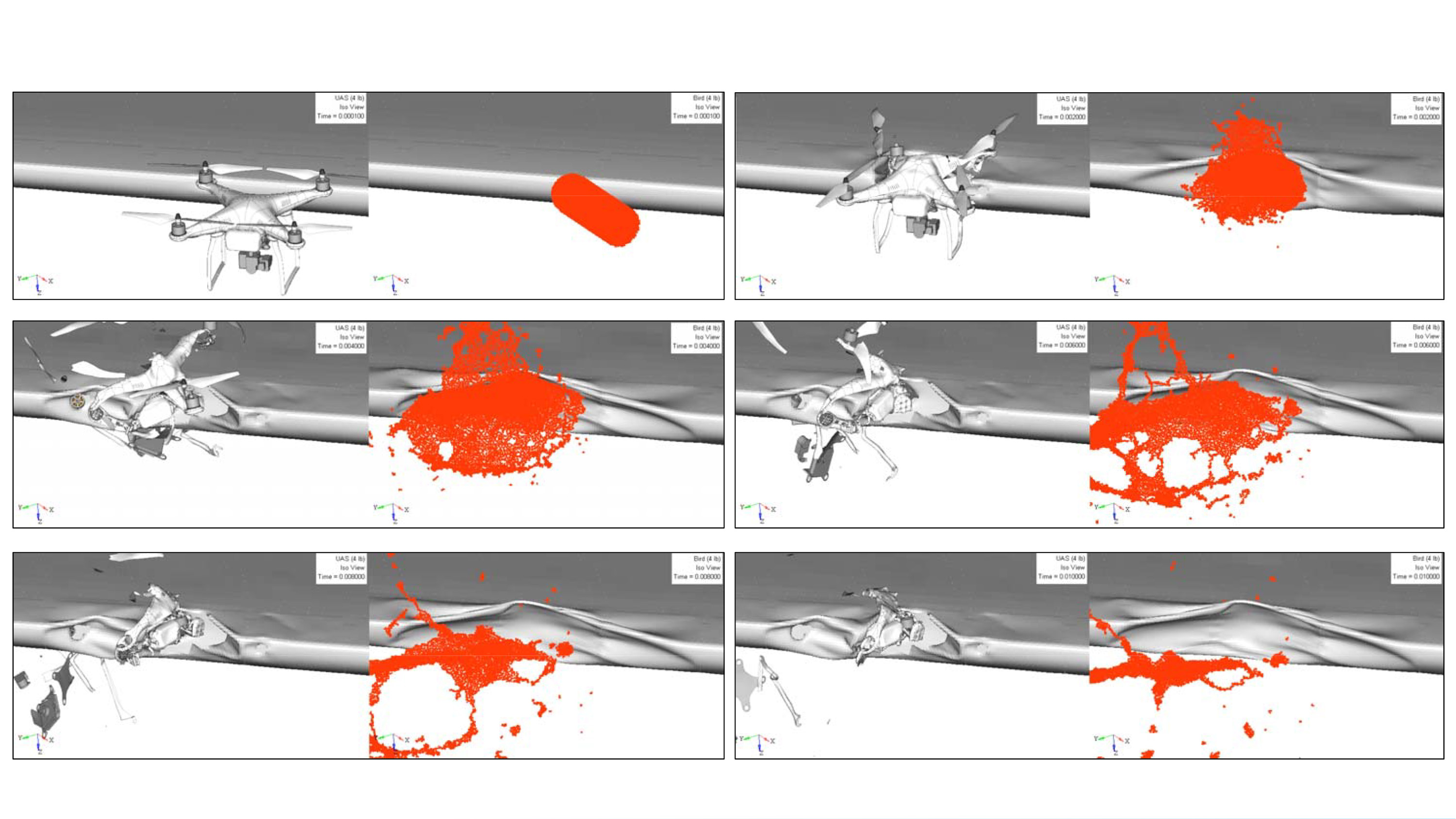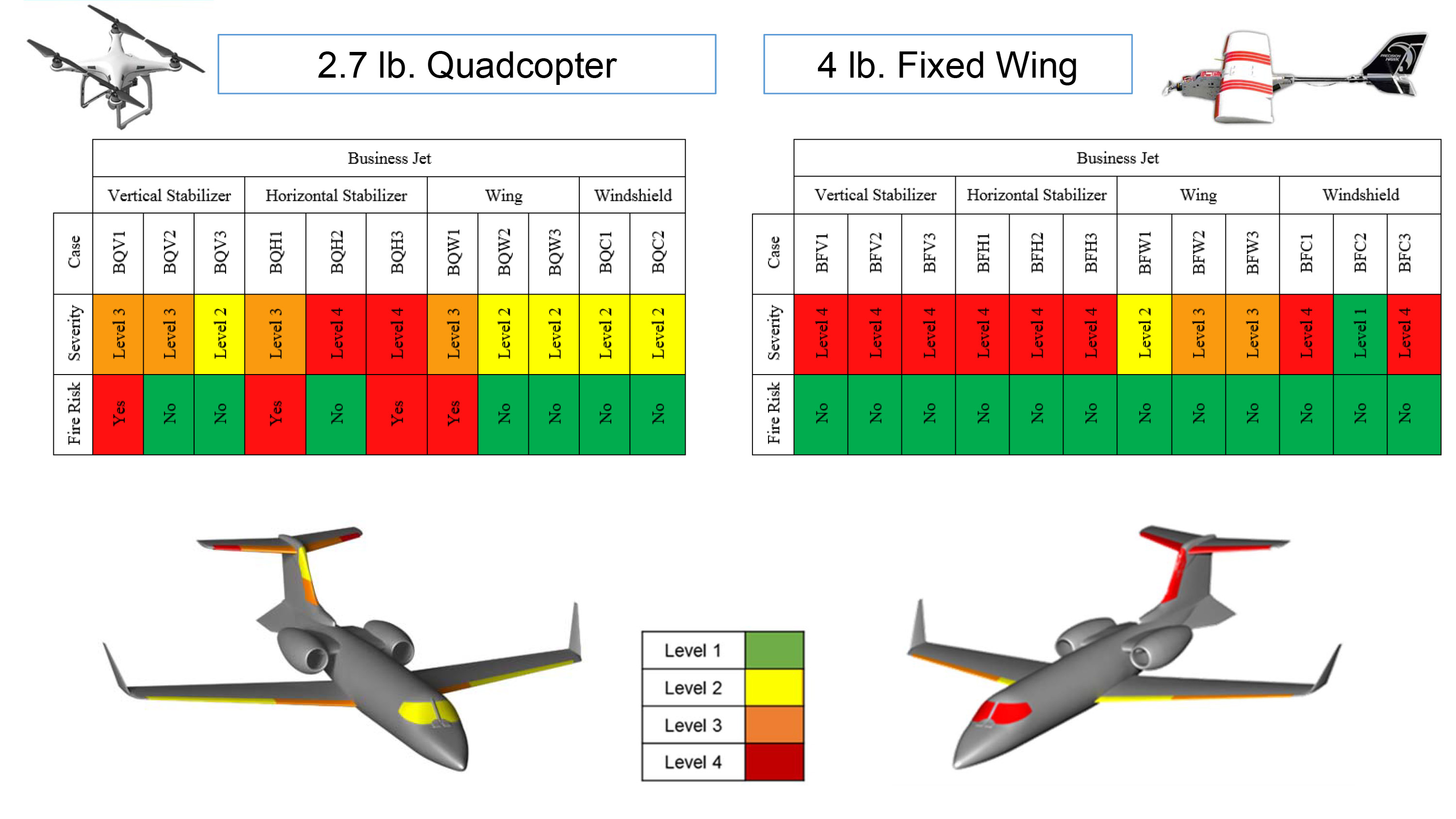Drone collisions with aircraft modeled
The results of the first study to use computer modeling to simulate midair collisions between manned and unmanned aircraft in detail strongly suggest that the danger of such real-world collisions must be taken seriously. Researchers found that the notoriously volatile lithium polymer batteries used to power most drones pose less risk of a post-impact fire than expected, but the structural damage a drone collision can create was more severe than expected.
Detailed results of a 14-month study by the FAA-funded Alliance for System Safety of UAS through Research Excellence (ASSURE) were published Nov. 28, and presented in a webinar led by Gerardo Olivares of Wichita State University, the principal investigator and leader of a collaboration that also involved Mississippi State University, Montana State University, and Ohio State University.
The research follows a study published in April that described in detail the impact energy and potential for injury if a drone strikes a person on the ground, and the ASSURE team plans to conduct midair collision modeling in the coming year to describe what happens when a drone strikes a representative general aviation aircraft and a helicopter. The results now published following a three-month peer review process suggest that smaller aircraft may be more vulnerable to post-impact fire due to lower impact velocities than the airliner or business jet, though researchers were careful to avoid stating such conclusions ahead of the detailed and methodical modeling.
The simulated drone strikes revealed that high-velocity impacts completely disintegrate the drone battery, and that the volatile material inside the battery, being widely dispersed, does not create the fire that lithium batteries are notorious for.

“It was a nice surprise to see them not have any explosions,” Olivares said during the webinar. On the other hand, he added, the damage done to aircraft structures, particularly on the horizontal and vertical stabilizers, was more severe than expected, penetrating the aircraft skin and compromising primary structures beneath in the worst cases. Olivares said such results came as “a surprise in certain areas.”
Researchers also modeled bird strikes for comparison, and were less surprised that an unmanned aircraft, which contains metal components, causes more severe damage when impacting an aircraft than a bird of the same weight.
“Even though we have the same kinetic energy … the damage to the structure is completely different from a bird and a small UAS,” Olivares said. The reason is that a bird is mostly composed of flesh, and flesh behaves more like a fluid in a high-velocity impact, dispersing the energy over a wider area with less likelihood of penetrating into the aircraft structure.
The researchers used some real-world impacts to validate their models, shooting drones and components including motors and batteries at aircraft components and sheets of aircraft aluminum to confirm that the computer simulations accurately reflect the real thing. The team disassembled a DJI Phantom quadcopter, which weighs 2.68 pounds, and a Precision Hawk Lancaster Hawkeye III fixed-wing drone, which weighs just under 4 pounds, and constructed a detailed digital model of each for the simulated impacts. They found the fixed-wing unmanned aircraft configuration tends to cause more severe damage to a manned aircraft, mainly because of its architecture and geometry. The internal components have less tendency to scatter and disperse during impact, focusing more energy over a given amount of surface area.
“This is something that we have to take seriously,” Olivares said. “They can cause damage to primary structures.”
Another significant difference between the two basic drone designs was revealed while modeling windshield collisions. The quadcopter never fully penetrated the windshield of the simulated business jet, according to the published findings, and neither design penetrated the windshield of the airliner, but the fixed-wing drone did penetrate the business jet windshield in some scenarios.
The findings suggest potential drone design changes could mitigate the severity of impact damage, such as using a pusher configuration for the motor and propeller, or incorporating softer materials.
While drone batteries completely disintegrate during high-velocity impacts, the post-impact fire risk could prove significantly higher as slower aircraft are modeled in the months to come.
“We observed that when you have 50 to 60 percent of the mass of the battery (intact) after impact, the batteries tend to heat up,” Olivares said.
Much work remains to be done to better understand the risks to manned aircraft in a collision with a drone. The researchers did not evaluate the likelihood of loss of control of the manned aircraft in any of the scenarios tested. The team did conclude that even relatively minor structural damage to the manned aircraft is potentially costly, and prevention of collisions by strict adherence to the current rules and operating guidelines for unmanned aircraft remains the most important line of defense. Unmanned aircraft makers may be able to mitigate some of the risk with design changes, and further development of “detect and avoid” capability for drones, along with electronic “geo-fencing” to segregate operations, but responsible piloting will remain of primary importance as drones continue to proliferate.
“The results of the study reinforce AOPA’s longstanding mission to ensure safety is a number one priority when integrating drones into the National Airspace System,” said Justin Barkowski, AOPA director of regulatory affairs. “We continue to engage and collaborate with the entire aviation community and are confident that the industry remains focused and committed to mitigating these risks and ensuring safety is at the forefront of all UAS operations.”





